Financial Statement Analysis of J. Sainsbury plc and Morrison plc
VerifiedAdded on 2020/07/22
|13
|4116
|29
AI Summary
The assignment is a detailed analysis of the financial statements of J. Sainsbury plc and Morrison plc. It evaluates various ratios such as interest cover, earnings per share, and dividends per share to assess the profitability position of both companies. The document concludes that J. Sainsbury plc has a more positive profitability position compared to Morrison plc.
Contribute Materials
Your contribution can guide someone’s learning journey. Share your
documents today.

MANAGING FINANCIAL
RESOURCES
RESOURCES
Secure Best Marks with AI Grader
Need help grading? Try our AI Grader for instant feedback on your assignments.
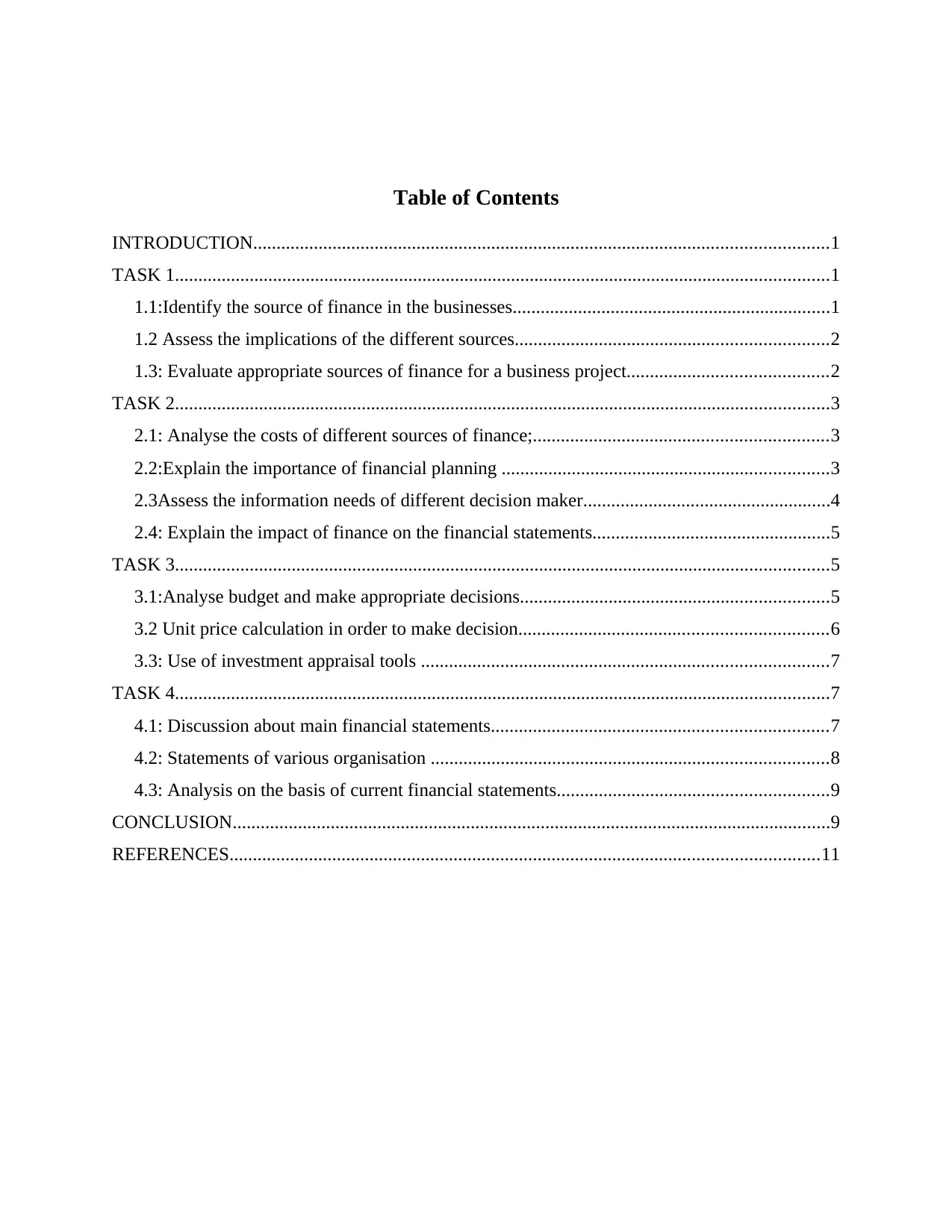
Table of Contents
INTRODUCTION...........................................................................................................................1
TASK 1............................................................................................................................................1
1.1:Identify the source of finance in the businesses....................................................................1
1.2 Assess the implications of the different sources...................................................................2
1.3: Evaluate appropriate sources of finance for a business project...........................................2
TASK 2............................................................................................................................................3
2.1: Analyse the costs of different sources of finance;...............................................................3
2.2:Explain the importance of financial planning ......................................................................3
2.3Assess the information needs of different decision maker.....................................................4
2.4: Explain the impact of finance on the financial statements...................................................5
TASK 3............................................................................................................................................5
3.1:Analyse budget and make appropriate decisions..................................................................5
3.2 Unit price calculation in order to make decision..................................................................6
3.3: Use of investment appraisal tools .......................................................................................7
TASK 4............................................................................................................................................7
4.1: Discussion about main financial statements........................................................................7
4.2: Statements of various organisation .....................................................................................8
4.3: Analysis on the basis of current financial statements..........................................................9
CONCLUSION................................................................................................................................9
REFERENCES..............................................................................................................................11
INTRODUCTION...........................................................................................................................1
TASK 1............................................................................................................................................1
1.1:Identify the source of finance in the businesses....................................................................1
1.2 Assess the implications of the different sources...................................................................2
1.3: Evaluate appropriate sources of finance for a business project...........................................2
TASK 2............................................................................................................................................3
2.1: Analyse the costs of different sources of finance;...............................................................3
2.2:Explain the importance of financial planning ......................................................................3
2.3Assess the information needs of different decision maker.....................................................4
2.4: Explain the impact of finance on the financial statements...................................................5
TASK 3............................................................................................................................................5
3.1:Analyse budget and make appropriate decisions..................................................................5
3.2 Unit price calculation in order to make decision..................................................................6
3.3: Use of investment appraisal tools .......................................................................................7
TASK 4............................................................................................................................................7
4.1: Discussion about main financial statements........................................................................7
4.2: Statements of various organisation .....................................................................................8
4.3: Analysis on the basis of current financial statements..........................................................9
CONCLUSION................................................................................................................................9
REFERENCES..............................................................................................................................11
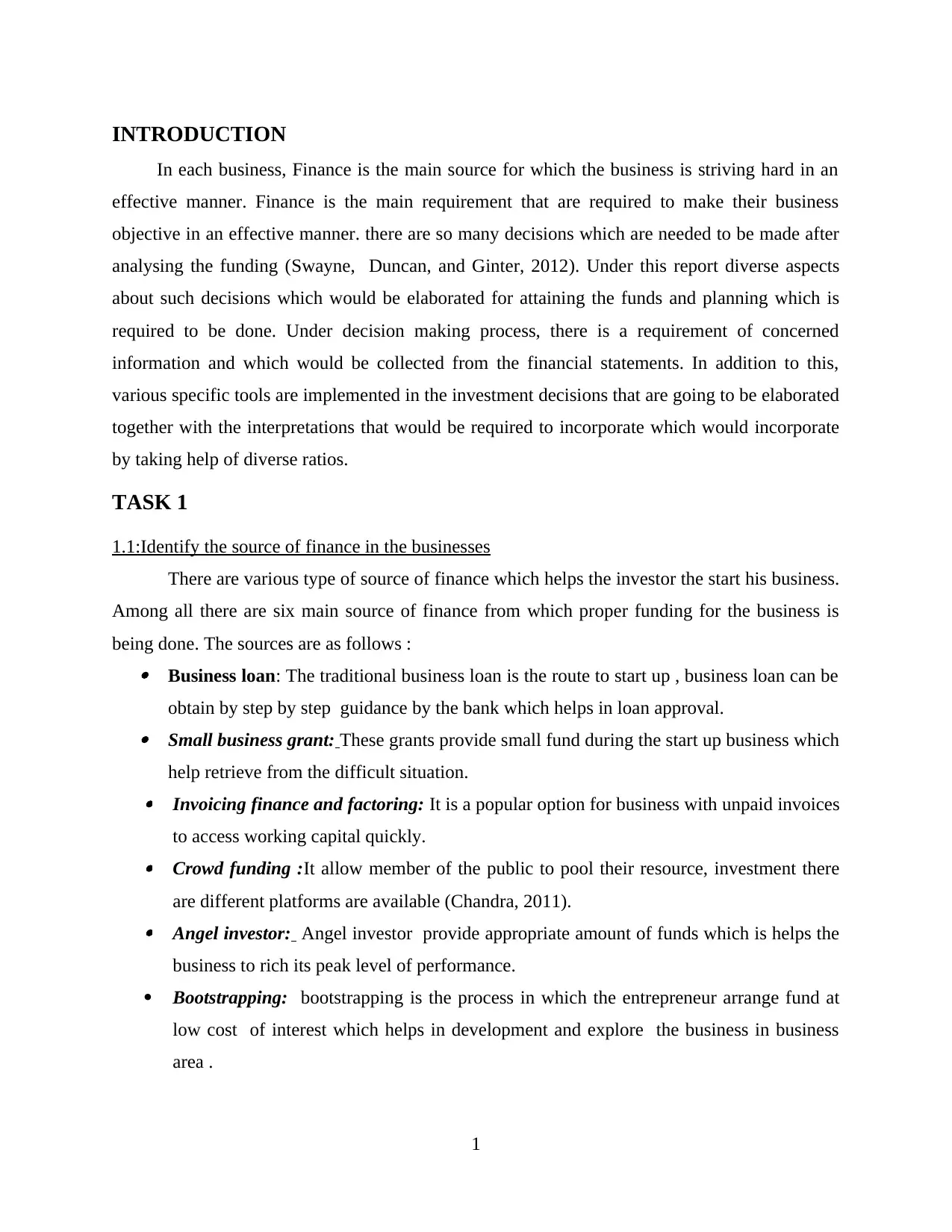
INTRODUCTION
In each business, Finance is the main source for which the business is striving hard in an
effective manner. Finance is the main requirement that are required to make their business
objective in an effective manner. there are so many decisions which are needed to be made after
analysing the funding (Swayne, Duncan, and Ginter, 2012). Under this report diverse aspects
about such decisions which would be elaborated for attaining the funds and planning which is
required to be done. Under decision making process, there is a requirement of concerned
information and which would be collected from the financial statements. In addition to this,
various specific tools are implemented in the investment decisions that are going to be elaborated
together with the interpretations that would be required to incorporate which would incorporate
by taking help of diverse ratios.
TASK 1
1.1:Identify the source of finance in the businesses
There are various type of source of finance which helps the investor the start his business.
Among all there are six main source of finance from which proper funding for the business is
being done. The sources are as follows : Business loan: The traditional business loan is the route to start up , business loan can be
obtain by step by step guidance by the bank which helps in loan approval. Small business grant: These grants provide small fund during the start up business which
help retrieve from the difficult situation. Invoicing finance and factoring: It is a popular option for business with unpaid invoices
to access working capital quickly. Crowd funding :It allow member of the public to pool their resource, investment there
are different platforms are available (Chandra, 2011). Angel investor: Angel investor provide appropriate amount of funds which is helps the
business to rich its peak level of performance.
Bootstrapping: bootstrapping is the process in which the entrepreneur arrange fund at
low cost of interest which helps in development and explore the business in business
area .
1
In each business, Finance is the main source for which the business is striving hard in an
effective manner. Finance is the main requirement that are required to make their business
objective in an effective manner. there are so many decisions which are needed to be made after
analysing the funding (Swayne, Duncan, and Ginter, 2012). Under this report diverse aspects
about such decisions which would be elaborated for attaining the funds and planning which is
required to be done. Under decision making process, there is a requirement of concerned
information and which would be collected from the financial statements. In addition to this,
various specific tools are implemented in the investment decisions that are going to be elaborated
together with the interpretations that would be required to incorporate which would incorporate
by taking help of diverse ratios.
TASK 1
1.1:Identify the source of finance in the businesses
There are various type of source of finance which helps the investor the start his business.
Among all there are six main source of finance from which proper funding for the business is
being done. The sources are as follows : Business loan: The traditional business loan is the route to start up , business loan can be
obtain by step by step guidance by the bank which helps in loan approval. Small business grant: These grants provide small fund during the start up business which
help retrieve from the difficult situation. Invoicing finance and factoring: It is a popular option for business with unpaid invoices
to access working capital quickly. Crowd funding :It allow member of the public to pool their resource, investment there
are different platforms are available (Chandra, 2011). Angel investor: Angel investor provide appropriate amount of funds which is helps the
business to rich its peak level of performance.
Bootstrapping: bootstrapping is the process in which the entrepreneur arrange fund at
low cost of interest which helps in development and explore the business in business
area .
1
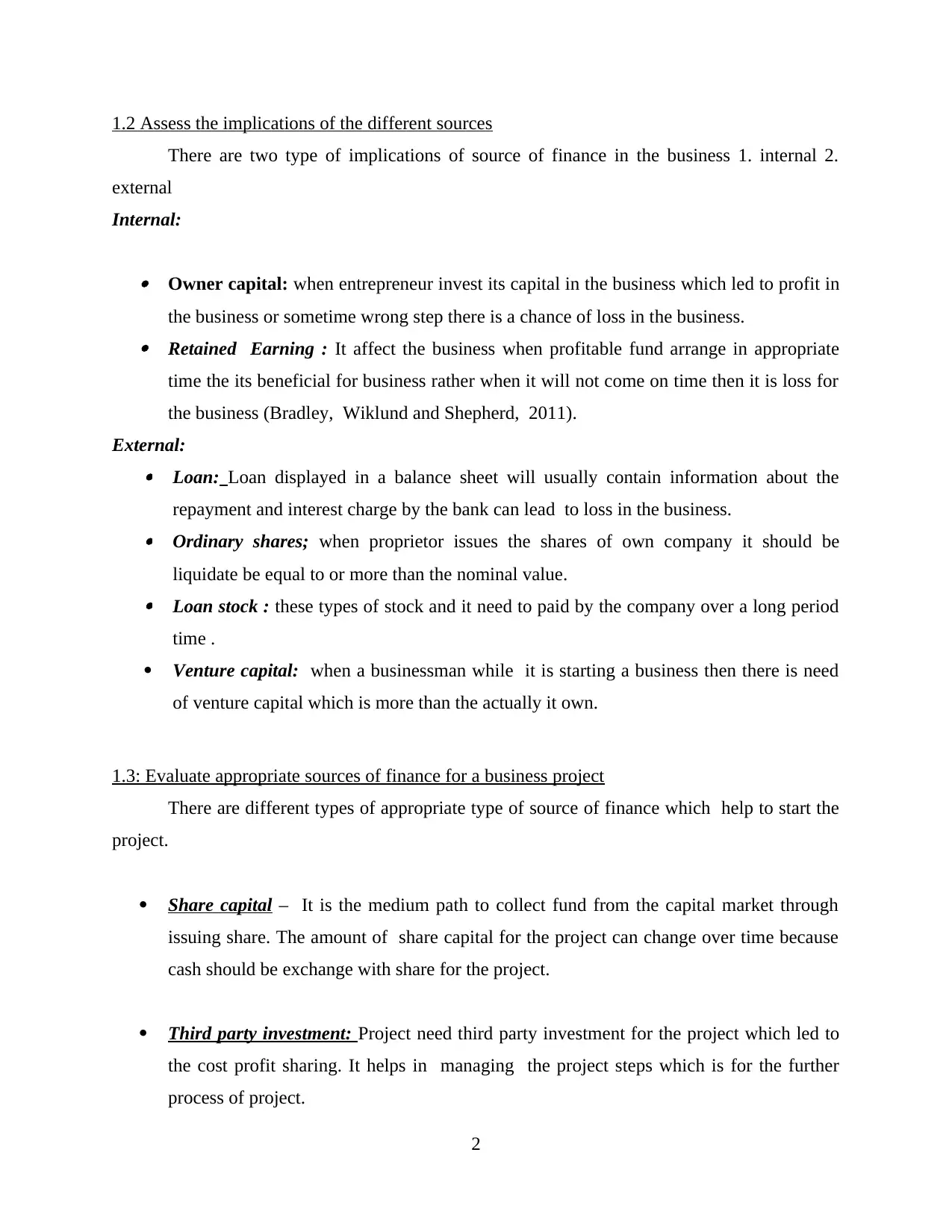
1.2 Assess the implications of the different sources
There are two type of implications of source of finance in the business 1. internal 2.
external
Internal:
Owner capital: when entrepreneur invest its capital in the business which led to profit in
the business or sometime wrong step there is a chance of loss in the business. Retained Earning : It affect the business when profitable fund arrange in appropriate
time the its beneficial for business rather when it will not come on time then it is loss for
the business (Bradley, Wiklund and Shepherd, 2011).
External: Loan: Loan displayed in a balance sheet will usually contain information about the
repayment and interest charge by the bank can lead to loss in the business. Ordinary shares; when proprietor issues the shares of own company it should be
liquidate be equal to or more than the nominal value. Loan stock : these types of stock and it need to paid by the company over a long period
time .
Venture capital: when a businessman while it is starting a business then there is need
of venture capital which is more than the actually it own.
1.3: Evaluate appropriate sources of finance for a business project
There are different types of appropriate type of source of finance which help to start the
project.
Share capital – It is the medium path to collect fund from the capital market through
issuing share. The amount of share capital for the project can change over time because
cash should be exchange with share for the project.
Third party investment: Project need third party investment for the project which led to
the cost profit sharing. It helps in managing the project steps which is for the further
process of project.
2
There are two type of implications of source of finance in the business 1. internal 2.
external
Internal:
Owner capital: when entrepreneur invest its capital in the business which led to profit in
the business or sometime wrong step there is a chance of loss in the business. Retained Earning : It affect the business when profitable fund arrange in appropriate
time the its beneficial for business rather when it will not come on time then it is loss for
the business (Bradley, Wiklund and Shepherd, 2011).
External: Loan: Loan displayed in a balance sheet will usually contain information about the
repayment and interest charge by the bank can lead to loss in the business. Ordinary shares; when proprietor issues the shares of own company it should be
liquidate be equal to or more than the nominal value. Loan stock : these types of stock and it need to paid by the company over a long period
time .
Venture capital: when a businessman while it is starting a business then there is need
of venture capital which is more than the actually it own.
1.3: Evaluate appropriate sources of finance for a business project
There are different types of appropriate type of source of finance which help to start the
project.
Share capital – It is the medium path to collect fund from the capital market through
issuing share. The amount of share capital for the project can change over time because
cash should be exchange with share for the project.
Third party investment: Project need third party investment for the project which led to
the cost profit sharing. It helps in managing the project steps which is for the further
process of project.
2
Secure Best Marks with AI Grader
Need help grading? Try our AI Grader for instant feedback on your assignments.
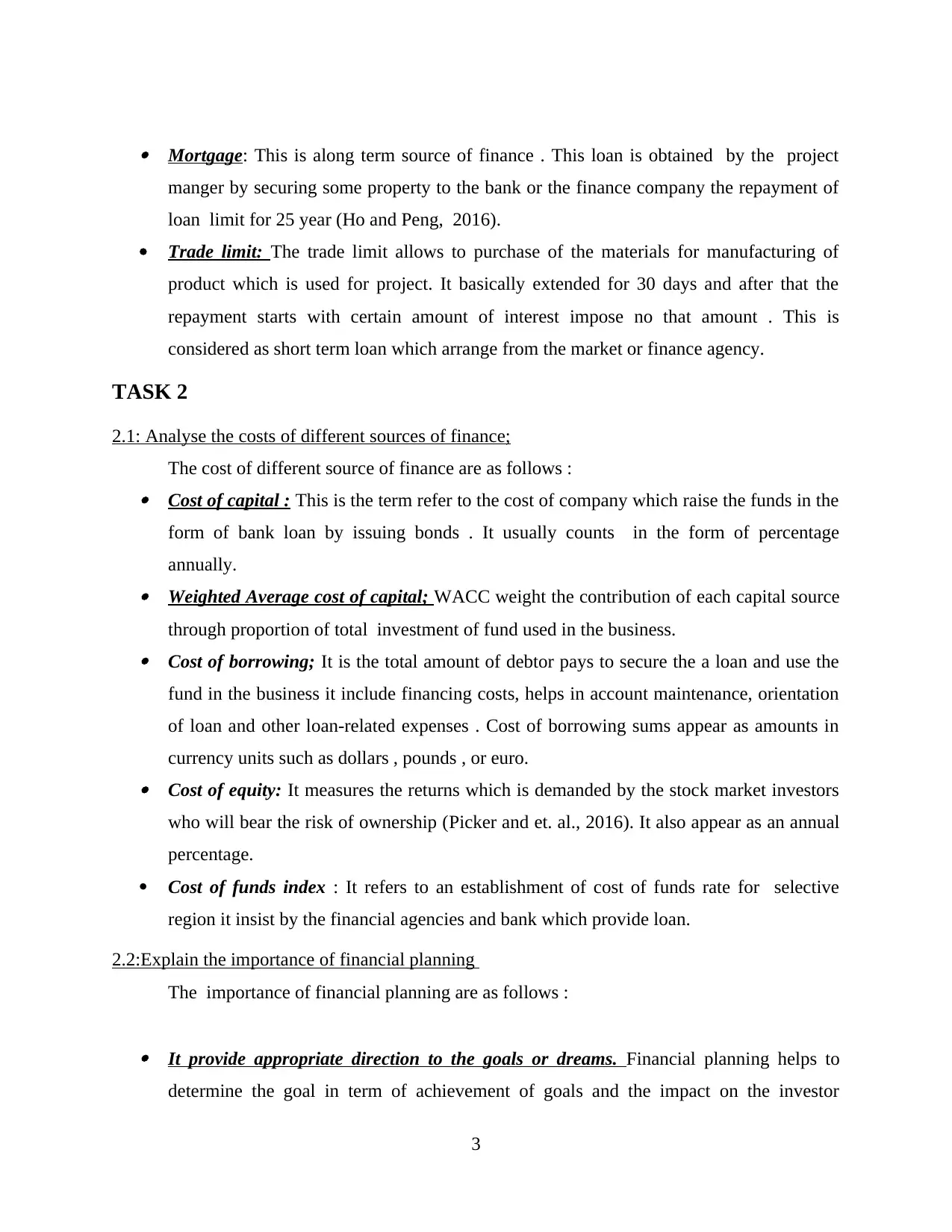
Mortgage: This is along term source of finance . This loan is obtained by the project
manger by securing some property to the bank or the finance company the repayment of
loan limit for 25 year (Ho and Peng, 2016).
Trade limit: The trade limit allows to purchase of the materials for manufacturing of
product which is used for project. It basically extended for 30 days and after that the
repayment starts with certain amount of interest impose no that amount . This is
considered as short term loan which arrange from the market or finance agency.
TASK 2
2.1: Analyse the costs of different sources of finance;
The cost of different source of finance are as follows : Cost of capital : This is the term refer to the cost of company which raise the funds in the
form of bank loan by issuing bonds . It usually counts in the form of percentage
annually. Weighted Average cost of capital; WACC weight the contribution of each capital source
through proportion of total investment of fund used in the business. Cost of borrowing; It is the total amount of debtor pays to secure the a loan and use the
fund in the business it include financing costs, helps in account maintenance, orientation
of loan and other loan-related expenses . Cost of borrowing sums appear as amounts in
currency units such as dollars , pounds , or euro. Cost of equity: It measures the returns which is demanded by the stock market investors
who will bear the risk of ownership (Picker and et. al., 2016). It also appear as an annual
percentage.
Cost of funds index : It refers to an establishment of cost of funds rate for selective
region it insist by the financial agencies and bank which provide loan.
2.2:Explain the importance of financial planning
The importance of financial planning are as follows :
It provide appropriate direction to the goals or dreams. Financial planning helps to
determine the goal in term of achievement of goals and the impact on the investor
3
manger by securing some property to the bank or the finance company the repayment of
loan limit for 25 year (Ho and Peng, 2016).
Trade limit: The trade limit allows to purchase of the materials for manufacturing of
product which is used for project. It basically extended for 30 days and after that the
repayment starts with certain amount of interest impose no that amount . This is
considered as short term loan which arrange from the market or finance agency.
TASK 2
2.1: Analyse the costs of different sources of finance;
The cost of different source of finance are as follows : Cost of capital : This is the term refer to the cost of company which raise the funds in the
form of bank loan by issuing bonds . It usually counts in the form of percentage
annually. Weighted Average cost of capital; WACC weight the contribution of each capital source
through proportion of total investment of fund used in the business. Cost of borrowing; It is the total amount of debtor pays to secure the a loan and use the
fund in the business it include financing costs, helps in account maintenance, orientation
of loan and other loan-related expenses . Cost of borrowing sums appear as amounts in
currency units such as dollars , pounds , or euro. Cost of equity: It measures the returns which is demanded by the stock market investors
who will bear the risk of ownership (Picker and et. al., 2016). It also appear as an annual
percentage.
Cost of funds index : It refers to an establishment of cost of funds rate for selective
region it insist by the financial agencies and bank which provide loan.
2.2:Explain the importance of financial planning
The importance of financial planning are as follows :
It provide appropriate direction to the goals or dreams. Financial planning helps to
determine the goal in term of achievement of goals and the impact on the investor
3
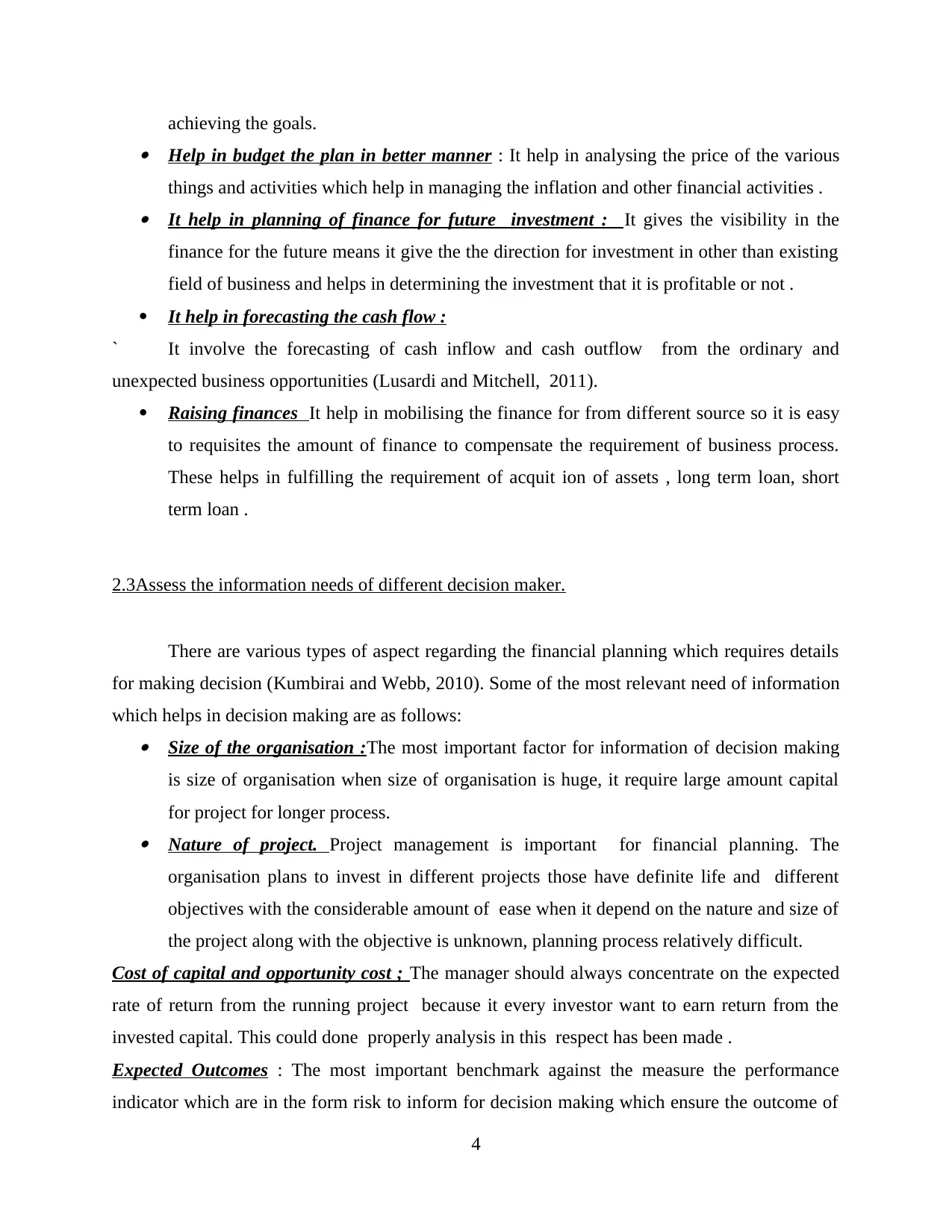
achieving the goals. Help in budget the plan in better manner : It help in analysing the price of the various
things and activities which help in managing the inflation and other financial activities . It help in planning of finance for future investment : It gives the visibility in the
finance for the future means it give the the direction for investment in other than existing
field of business and helps in determining the investment that it is profitable or not .
It help in forecasting the cash flow :
` It involve the forecasting of cash inflow and cash outflow from the ordinary and
unexpected business opportunities (Lusardi and Mitchell, 2011).
Raising finances It help in mobilising the finance for from different source so it is easy
to requisites the amount of finance to compensate the requirement of business process.
These helps in fulfilling the requirement of acquit ion of assets , long term loan, short
term loan .
2.3Assess the information needs of different decision maker.
There are various types of aspect regarding the financial planning which requires details
for making decision (Kumbirai and Webb, 2010). Some of the most relevant need of information
which helps in decision making are as follows: Size of the organisation :The most important factor for information of decision making
is size of organisation when size of organisation is huge, it require large amount capital
for project for longer process. Nature of project. Project management is important for financial planning. The
organisation plans to invest in different projects those have definite life and different
objectives with the considerable amount of ease when it depend on the nature and size of
the project along with the objective is unknown, planning process relatively difficult.
Cost of capital and opportunity cost ; The manager should always concentrate on the expected
rate of return from the running project because it every investor want to earn return from the
invested capital. This could done properly analysis in this respect has been made .
Expected Outcomes : The most important benchmark against the measure the performance
indicator which are in the form risk to inform for decision making which ensure the outcome of
4
things and activities which help in managing the inflation and other financial activities . It help in planning of finance for future investment : It gives the visibility in the
finance for the future means it give the the direction for investment in other than existing
field of business and helps in determining the investment that it is profitable or not .
It help in forecasting the cash flow :
` It involve the forecasting of cash inflow and cash outflow from the ordinary and
unexpected business opportunities (Lusardi and Mitchell, 2011).
Raising finances It help in mobilising the finance for from different source so it is easy
to requisites the amount of finance to compensate the requirement of business process.
These helps in fulfilling the requirement of acquit ion of assets , long term loan, short
term loan .
2.3Assess the information needs of different decision maker.
There are various types of aspect regarding the financial planning which requires details
for making decision (Kumbirai and Webb, 2010). Some of the most relevant need of information
which helps in decision making are as follows: Size of the organisation :The most important factor for information of decision making
is size of organisation when size of organisation is huge, it require large amount capital
for project for longer process. Nature of project. Project management is important for financial planning. The
organisation plans to invest in different projects those have definite life and different
objectives with the considerable amount of ease when it depend on the nature and size of
the project along with the objective is unknown, planning process relatively difficult.
Cost of capital and opportunity cost ; The manager should always concentrate on the expected
rate of return from the running project because it every investor want to earn return from the
invested capital. This could done properly analysis in this respect has been made .
Expected Outcomes : The most important benchmark against the measure the performance
indicator which are in the form risk to inform for decision making which ensure the outcome of
4
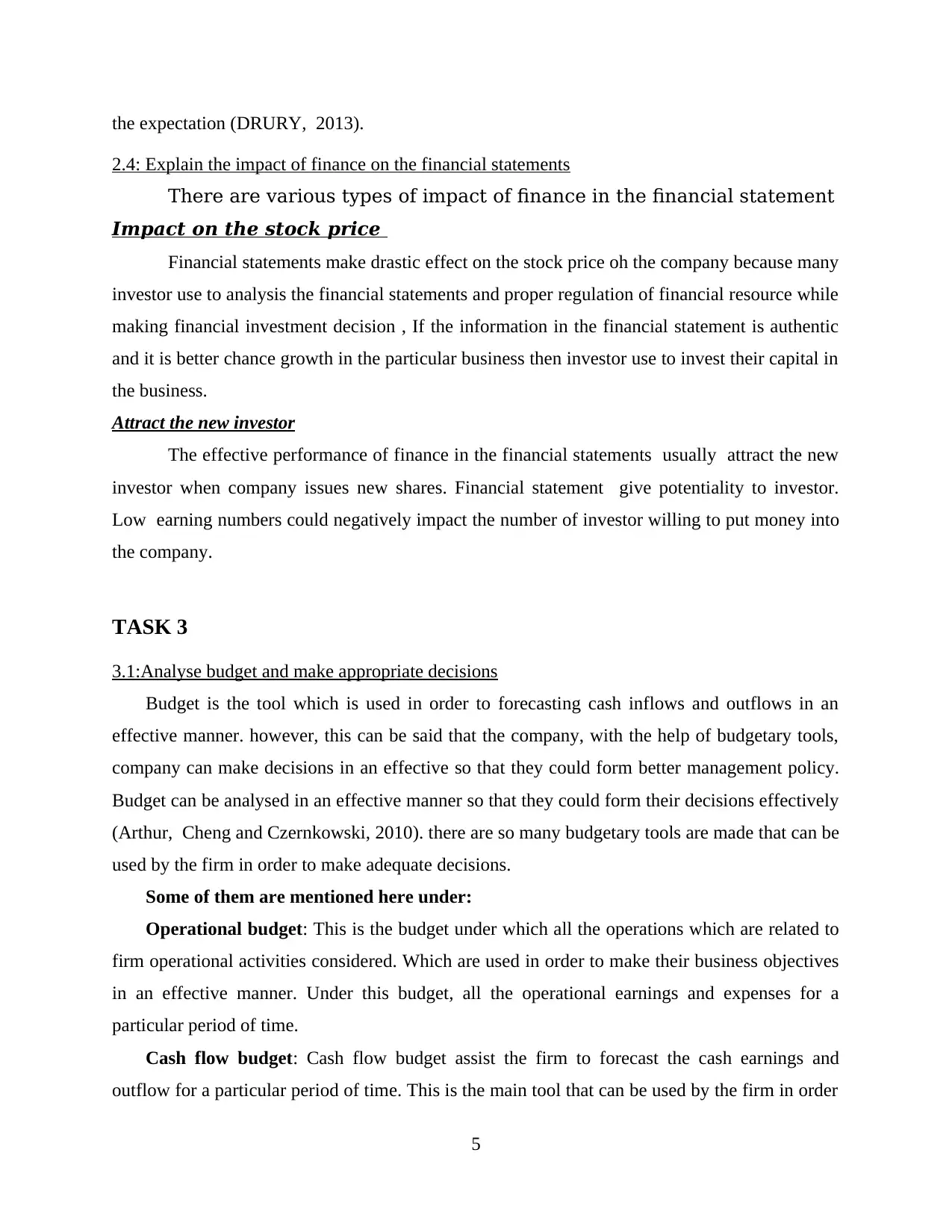
the expectation (DRURY, 2013).
2.4: Explain the impact of finance on the financial statements
There are various types of impact of finance in the financial statement
Impact on the stock price
Financial statements make drastic effect on the stock price oh the company because many
investor use to analysis the financial statements and proper regulation of financial resource while
making financial investment decision , If the information in the financial statement is authentic
and it is better chance growth in the particular business then investor use to invest their capital in
the business.
Attract the new investor
The effective performance of finance in the financial statements usually attract the new
investor when company issues new shares. Financial statement give potentiality to investor.
Low earning numbers could negatively impact the number of investor willing to put money into
the company.
TASK 3
3.1:Analyse budget and make appropriate decisions
Budget is the tool which is used in order to forecasting cash inflows and outflows in an
effective manner. however, this can be said that the company, with the help of budgetary tools,
company can make decisions in an effective so that they could form better management policy.
Budget can be analysed in an effective manner so that they could form their decisions effectively
(Arthur, Cheng and Czernkowski, 2010). there are so many budgetary tools are made that can be
used by the firm in order to make adequate decisions.
Some of them are mentioned here under:
Operational budget: This is the budget under which all the operations which are related to
firm operational activities considered. Which are used in order to make their business objectives
in an effective manner. Under this budget, all the operational earnings and expenses for a
particular period of time.
Cash flow budget: Cash flow budget assist the firm to forecast the cash earnings and
outflow for a particular period of time. This is the main tool that can be used by the firm in order
5
2.4: Explain the impact of finance on the financial statements
There are various types of impact of finance in the financial statement
Impact on the stock price
Financial statements make drastic effect on the stock price oh the company because many
investor use to analysis the financial statements and proper regulation of financial resource while
making financial investment decision , If the information in the financial statement is authentic
and it is better chance growth in the particular business then investor use to invest their capital in
the business.
Attract the new investor
The effective performance of finance in the financial statements usually attract the new
investor when company issues new shares. Financial statement give potentiality to investor.
Low earning numbers could negatively impact the number of investor willing to put money into
the company.
TASK 3
3.1:Analyse budget and make appropriate decisions
Budget is the tool which is used in order to forecasting cash inflows and outflows in an
effective manner. however, this can be said that the company, with the help of budgetary tools,
company can make decisions in an effective so that they could form better management policy.
Budget can be analysed in an effective manner so that they could form their decisions effectively
(Arthur, Cheng and Czernkowski, 2010). there are so many budgetary tools are made that can be
used by the firm in order to make adequate decisions.
Some of them are mentioned here under:
Operational budget: This is the budget under which all the operations which are related to
firm operational activities considered. Which are used in order to make their business objectives
in an effective manner. Under this budget, all the operational earnings and expenses for a
particular period of time.
Cash flow budget: Cash flow budget assist the firm to forecast the cash earnings and
outflow for a particular period of time. This is the main tool that can be used by the firm in order
5
Paraphrase This Document
Need a fresh take? Get an instant paraphrase of this document with our AI Paraphraser
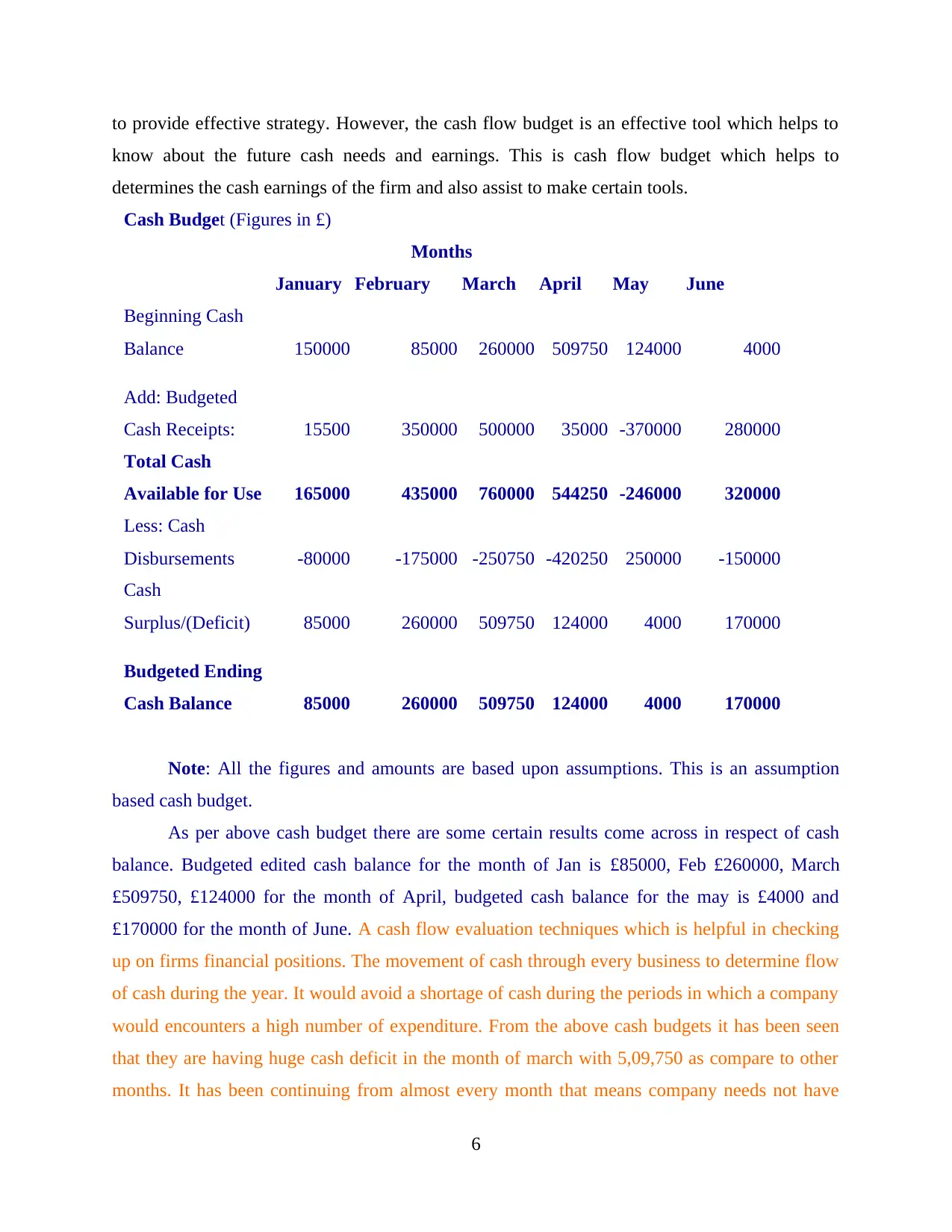
to provide effective strategy. However, the cash flow budget is an effective tool which helps to
know about the future cash needs and earnings. This is cash flow budget which helps to
determines the cash earnings of the firm and also assist to make certain tools.
Cash Budget (Figures in £)
Months
January February March April May June
Beginning Cash
Balance 150000 85000 260000 509750 124000 4000
Add: Budgeted
Cash Receipts: 15500 350000 500000 35000 -370000 280000
Total Cash
Available for Use 165000 435000 760000 544250 -246000 320000
Less: Cash
Disbursements -80000 -175000 -250750 -420250 250000 -150000
Cash
Surplus/(Deficit) 85000 260000 509750 124000 4000 170000
Budgeted Ending
Cash Balance 85000 260000 509750 124000 4000 170000
Note: All the figures and amounts are based upon assumptions. This is an assumption
based cash budget.
As per above cash budget there are some certain results come across in respect of cash
balance. Budgeted edited cash balance for the month of Jan is £85000, Feb £260000, March
£509750, £124000 for the month of April, budgeted cash balance for the may is £4000 and
£170000 for the month of June. A cash flow evaluation techniques which is helpful in checking
up on firms financial positions. The movement of cash through every business to determine flow
of cash during the year. It would avoid a shortage of cash during the periods in which a company
would encounters a high number of expenditure. From the above cash budgets it has been seen
that they are having huge cash deficit in the month of march with 5,09,750 as compare to other
months. It has been continuing from almost every month that means company needs not have
6
know about the future cash needs and earnings. This is cash flow budget which helps to
determines the cash earnings of the firm and also assist to make certain tools.
Cash Budget (Figures in £)
Months
January February March April May June
Beginning Cash
Balance 150000 85000 260000 509750 124000 4000
Add: Budgeted
Cash Receipts: 15500 350000 500000 35000 -370000 280000
Total Cash
Available for Use 165000 435000 760000 544250 -246000 320000
Less: Cash
Disbursements -80000 -175000 -250750 -420250 250000 -150000
Cash
Surplus/(Deficit) 85000 260000 509750 124000 4000 170000
Budgeted Ending
Cash Balance 85000 260000 509750 124000 4000 170000
Note: All the figures and amounts are based upon assumptions. This is an assumption
based cash budget.
As per above cash budget there are some certain results come across in respect of cash
balance. Budgeted edited cash balance for the month of Jan is £85000, Feb £260000, March
£509750, £124000 for the month of April, budgeted cash balance for the may is £4000 and
£170000 for the month of June. A cash flow evaluation techniques which is helpful in checking
up on firms financial positions. The movement of cash through every business to determine flow
of cash during the year. It would avoid a shortage of cash during the periods in which a company
would encounters a high number of expenditure. From the above cash budgets it has been seen
that they are having huge cash deficit in the month of march with 5,09,750 as compare to other
months. It has been continuing from almost every month that means company needs not have
6
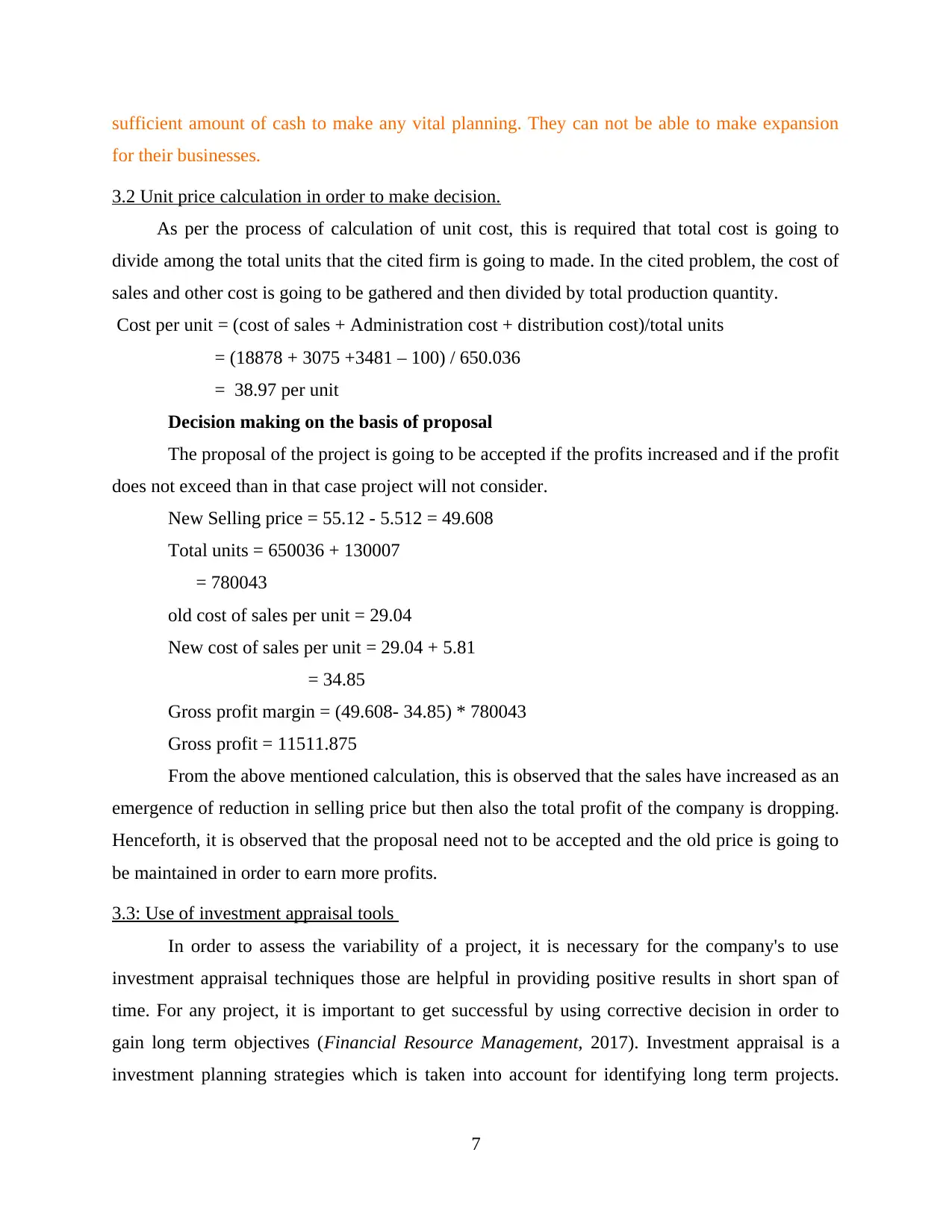
sufficient amount of cash to make any vital planning. They can not be able to make expansion
for their businesses.
3.2 Unit price calculation in order to make decision.
As per the process of calculation of unit cost, this is required that total cost is going to
divide among the total units that the cited firm is going to made. In the cited problem, the cost of
sales and other cost is going to be gathered and then divided by total production quantity.
Cost per unit = (cost of sales + Administration cost + distribution cost)/total units
= (18878 + 3075 +3481 – 100) / 650.036
= 38.97 per unit
Decision making on the basis of proposal
The proposal of the project is going to be accepted if the profits increased and if the profit
does not exceed than in that case project will not consider.
New Selling price = 55.12 - 5.512 = 49.608
Total units = 650036 + 130007
= 780043
old cost of sales per unit = 29.04
New cost of sales per unit = 29.04 + 5.81
= 34.85
Gross profit margin = (49.608- 34.85) * 780043
Gross profit = 11511.875
From the above mentioned calculation, this is observed that the sales have increased as an
emergence of reduction in selling price but then also the total profit of the company is dropping.
Henceforth, it is observed that the proposal need not to be accepted and the old price is going to
be maintained in order to earn more profits.
3.3: Use of investment appraisal tools
In order to assess the variability of a project, it is necessary for the company's to use
investment appraisal techniques those are helpful in providing positive results in short span of
time. For any project, it is important to get successful by using corrective decision in order to
gain long term objectives (Financial Resource Management, 2017). Investment appraisal is a
investment planning strategies which is taken into account for identifying long term projects.
7
for their businesses.
3.2 Unit price calculation in order to make decision.
As per the process of calculation of unit cost, this is required that total cost is going to
divide among the total units that the cited firm is going to made. In the cited problem, the cost of
sales and other cost is going to be gathered and then divided by total production quantity.
Cost per unit = (cost of sales + Administration cost + distribution cost)/total units
= (18878 + 3075 +3481 – 100) / 650.036
= 38.97 per unit
Decision making on the basis of proposal
The proposal of the project is going to be accepted if the profits increased and if the profit
does not exceed than in that case project will not consider.
New Selling price = 55.12 - 5.512 = 49.608
Total units = 650036 + 130007
= 780043
old cost of sales per unit = 29.04
New cost of sales per unit = 29.04 + 5.81
= 34.85
Gross profit margin = (49.608- 34.85) * 780043
Gross profit = 11511.875
From the above mentioned calculation, this is observed that the sales have increased as an
emergence of reduction in selling price but then also the total profit of the company is dropping.
Henceforth, it is observed that the proposal need not to be accepted and the old price is going to
be maintained in order to earn more profits.
3.3: Use of investment appraisal tools
In order to assess the variability of a project, it is necessary for the company's to use
investment appraisal techniques those are helpful in providing positive results in short span of
time. For any project, it is important to get successful by using corrective decision in order to
gain long term objectives (Financial Resource Management, 2017). Investment appraisal is a
investment planning strategies which is taken into account for identifying long term projects.
7
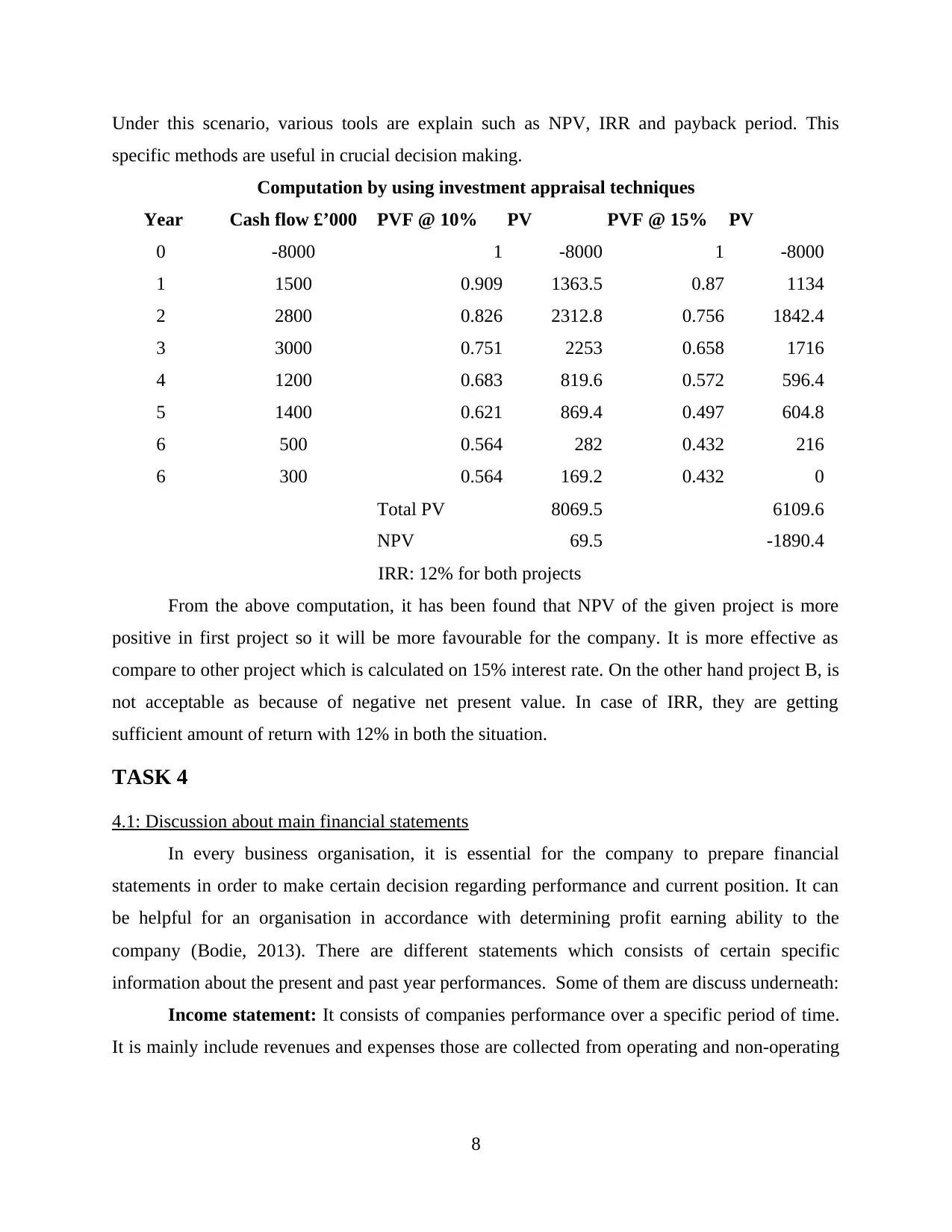
Under this scenario, various tools are explain such as NPV, IRR and payback period. This
specific methods are useful in crucial decision making.
Computation by using investment appraisal techniques
Year Cash flow £’000 PVF @ 10% PV PVF @ 15% PV
0 -8000 1 -8000 1 -8000
1 1500 0.909 1363.5 0.87 1134
2 2800 0.826 2312.8 0.756 1842.4
3 3000 0.751 2253 0.658 1716
4 1200 0.683 819.6 0.572 596.4
5 1400 0.621 869.4 0.497 604.8
6 500 0.564 282 0.432 216
6 300 0.564 169.2 0.432 0
Total PV 8069.5 6109.6
NPV 69.5 -1890.4
IRR: 12% for both projects
From the above computation, it has been found that NPV of the given project is more
positive in first project so it will be more favourable for the company. It is more effective as
compare to other project which is calculated on 15% interest rate. On the other hand project B, is
not acceptable as because of negative net present value. In case of IRR, they are getting
sufficient amount of return with 12% in both the situation.
TASK 4
4.1: Discussion about main financial statements
In every business organisation, it is essential for the company to prepare financial
statements in order to make certain decision regarding performance and current position. It can
be helpful for an organisation in accordance with determining profit earning ability to the
company (Bodie, 2013). There are different statements which consists of certain specific
information about the present and past year performances. Some of them are discuss underneath:
Income statement: It consists of companies performance over a specific period of time.
It is mainly include revenues and expenses those are collected from operating and non-operating
8
specific methods are useful in crucial decision making.
Computation by using investment appraisal techniques
Year Cash flow £’000 PVF @ 10% PV PVF @ 15% PV
0 -8000 1 -8000 1 -8000
1 1500 0.909 1363.5 0.87 1134
2 2800 0.826 2312.8 0.756 1842.4
3 3000 0.751 2253 0.658 1716
4 1200 0.683 819.6 0.572 596.4
5 1400 0.621 869.4 0.497 604.8
6 500 0.564 282 0.432 216
6 300 0.564 169.2 0.432 0
Total PV 8069.5 6109.6
NPV 69.5 -1890.4
IRR: 12% for both projects
From the above computation, it has been found that NPV of the given project is more
positive in first project so it will be more favourable for the company. It is more effective as
compare to other project which is calculated on 15% interest rate. On the other hand project B, is
not acceptable as because of negative net present value. In case of IRR, they are getting
sufficient amount of return with 12% in both the situation.
TASK 4
4.1: Discussion about main financial statements
In every business organisation, it is essential for the company to prepare financial
statements in order to make certain decision regarding performance and current position. It can
be helpful for an organisation in accordance with determining profit earning ability to the
company (Bodie, 2013). There are different statements which consists of certain specific
information about the present and past year performances. Some of them are discuss underneath:
Income statement: It consists of companies performance over a specific period of time.
It is mainly include revenues and expenses those are collected from operating and non-operating
8
Secure Best Marks with AI Grader
Need help grading? Try our AI Grader for instant feedback on your assignments.
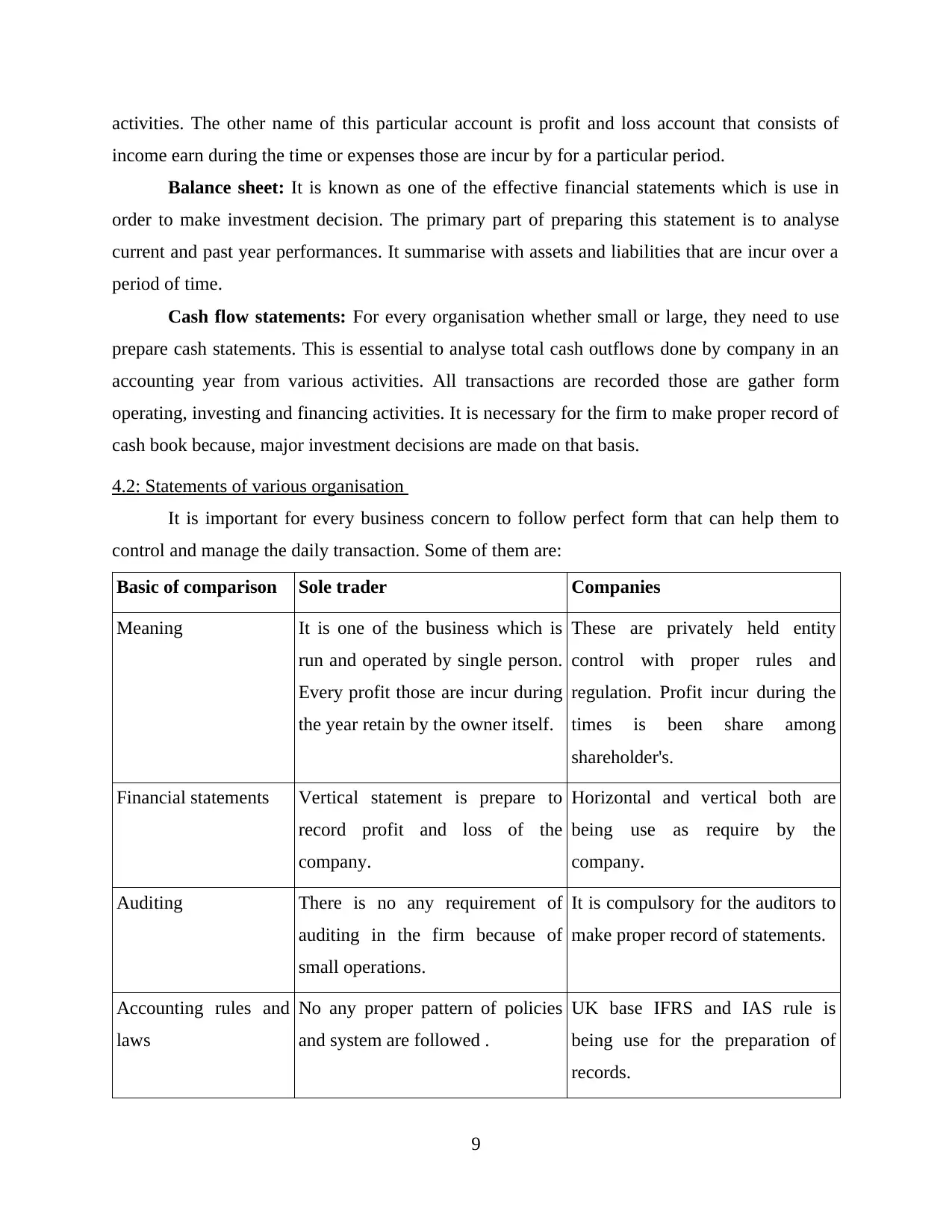
activities. The other name of this particular account is profit and loss account that consists of
income earn during the time or expenses those are incur by for a particular period.
Balance sheet: It is known as one of the effective financial statements which is use in
order to make investment decision. The primary part of preparing this statement is to analyse
current and past year performances. It summarise with assets and liabilities that are incur over a
period of time.
Cash flow statements: For every organisation whether small or large, they need to use
prepare cash statements. This is essential to analyse total cash outflows done by company in an
accounting year from various activities. All transactions are recorded those are gather form
operating, investing and financing activities. It is necessary for the firm to make proper record of
cash book because, major investment decisions are made on that basis.
4.2: Statements of various organisation
It is important for every business concern to follow perfect form that can help them to
control and manage the daily transaction. Some of them are:
Basic of comparison Sole trader Companies
Meaning It is one of the business which is
run and operated by single person.
Every profit those are incur during
the year retain by the owner itself.
These are privately held entity
control with proper rules and
regulation. Profit incur during the
times is been share among
shareholder's.
Financial statements Vertical statement is prepare to
record profit and loss of the
company.
Horizontal and vertical both are
being use as require by the
company.
Auditing There is no any requirement of
auditing in the firm because of
small operations.
It is compulsory for the auditors to
make proper record of statements.
Accounting rules and
laws
No any proper pattern of policies
and system are followed .
UK base IFRS and IAS rule is
being use for the preparation of
records.
9
income earn during the time or expenses those are incur by for a particular period.
Balance sheet: It is known as one of the effective financial statements which is use in
order to make investment decision. The primary part of preparing this statement is to analyse
current and past year performances. It summarise with assets and liabilities that are incur over a
period of time.
Cash flow statements: For every organisation whether small or large, they need to use
prepare cash statements. This is essential to analyse total cash outflows done by company in an
accounting year from various activities. All transactions are recorded those are gather form
operating, investing and financing activities. It is necessary for the firm to make proper record of
cash book because, major investment decisions are made on that basis.
4.2: Statements of various organisation
It is important for every business concern to follow perfect form that can help them to
control and manage the daily transaction. Some of them are:
Basic of comparison Sole trader Companies
Meaning It is one of the business which is
run and operated by single person.
Every profit those are incur during
the year retain by the owner itself.
These are privately held entity
control with proper rules and
regulation. Profit incur during the
times is been share among
shareholder's.
Financial statements Vertical statement is prepare to
record profit and loss of the
company.
Horizontal and vertical both are
being use as require by the
company.
Auditing There is no any requirement of
auditing in the firm because of
small operations.
It is compulsory for the auditors to
make proper record of statements.
Accounting rules and
laws
No any proper pattern of policies
and system are followed .
UK base IFRS and IAS rule is
being use for the preparation of
records.
9
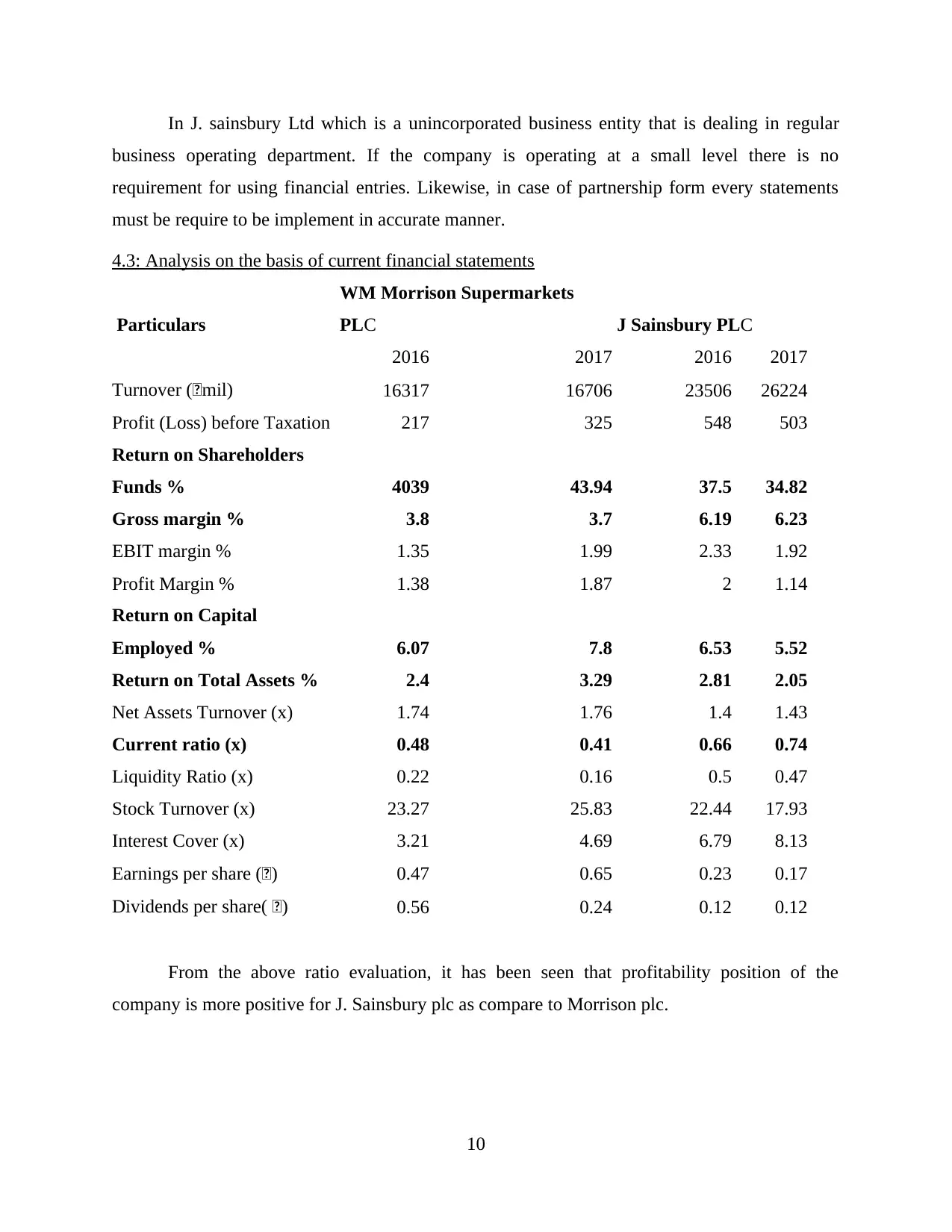
In J. sainsbury Ltd which is a unincorporated business entity that is dealing in regular
business operating department. If the company is operating at a small level there is no
requirement for using financial entries. Likewise, in case of partnership form every statements
must be require to be implement in accurate manner.
4.3: Analysis on the basis of current financial statements
Particulars
WM Morrison Supermarkets
PLC J Sainsbury PLC
2016 2017 2016 2017
Turnover (£mil) 16317 16706 23506 26224
Profit (Loss) before Taxation 217 325 548 503
Return on Shareholders
Funds % 4039 43.94 37.5 34.82
Gross margin % 3.8 3.7 6.19 6.23
EBIT margin % 1.35 1.99 2.33 1.92
Profit Margin % 1.38 1.87 2 1.14
Return on Capital
Employed % 6.07 7.8 6.53 5.52
Return on Total Assets % 2.4 3.29 2.81 2.05
Net Assets Turnover (x) 1.74 1.76 1.4 1.43
Current ratio (x) 0.48 0.41 0.66 0.74
Liquidity Ratio (x) 0.22 0.16 0.5 0.47
Stock Turnover (x) 23.27 25.83 22.44 17.93
Interest Cover (x) 3.21 4.69 6.79 8.13
Earnings per share (£) 0.47 0.65 0.23 0.17
Dividends per share( £) 0.56 0.24 0.12 0.12
From the above ratio evaluation, it has been seen that profitability position of the
company is more positive for J. Sainsbury plc as compare to Morrison plc.
10
business operating department. If the company is operating at a small level there is no
requirement for using financial entries. Likewise, in case of partnership form every statements
must be require to be implement in accurate manner.
4.3: Analysis on the basis of current financial statements
Particulars
WM Morrison Supermarkets
PLC J Sainsbury PLC
2016 2017 2016 2017
Turnover (£mil) 16317 16706 23506 26224
Profit (Loss) before Taxation 217 325 548 503
Return on Shareholders
Funds % 4039 43.94 37.5 34.82
Gross margin % 3.8 3.7 6.19 6.23
EBIT margin % 1.35 1.99 2.33 1.92
Profit Margin % 1.38 1.87 2 1.14
Return on Capital
Employed % 6.07 7.8 6.53 5.52
Return on Total Assets % 2.4 3.29 2.81 2.05
Net Assets Turnover (x) 1.74 1.76 1.4 1.43
Current ratio (x) 0.48 0.41 0.66 0.74
Liquidity Ratio (x) 0.22 0.16 0.5 0.47
Stock Turnover (x) 23.27 25.83 22.44 17.93
Interest Cover (x) 3.21 4.69 6.79 8.13
Earnings per share (£) 0.47 0.65 0.23 0.17
Dividends per share( £) 0.56 0.24 0.12 0.12
From the above ratio evaluation, it has been seen that profitability position of the
company is more positive for J. Sainsbury plc as compare to Morrison plc.
10
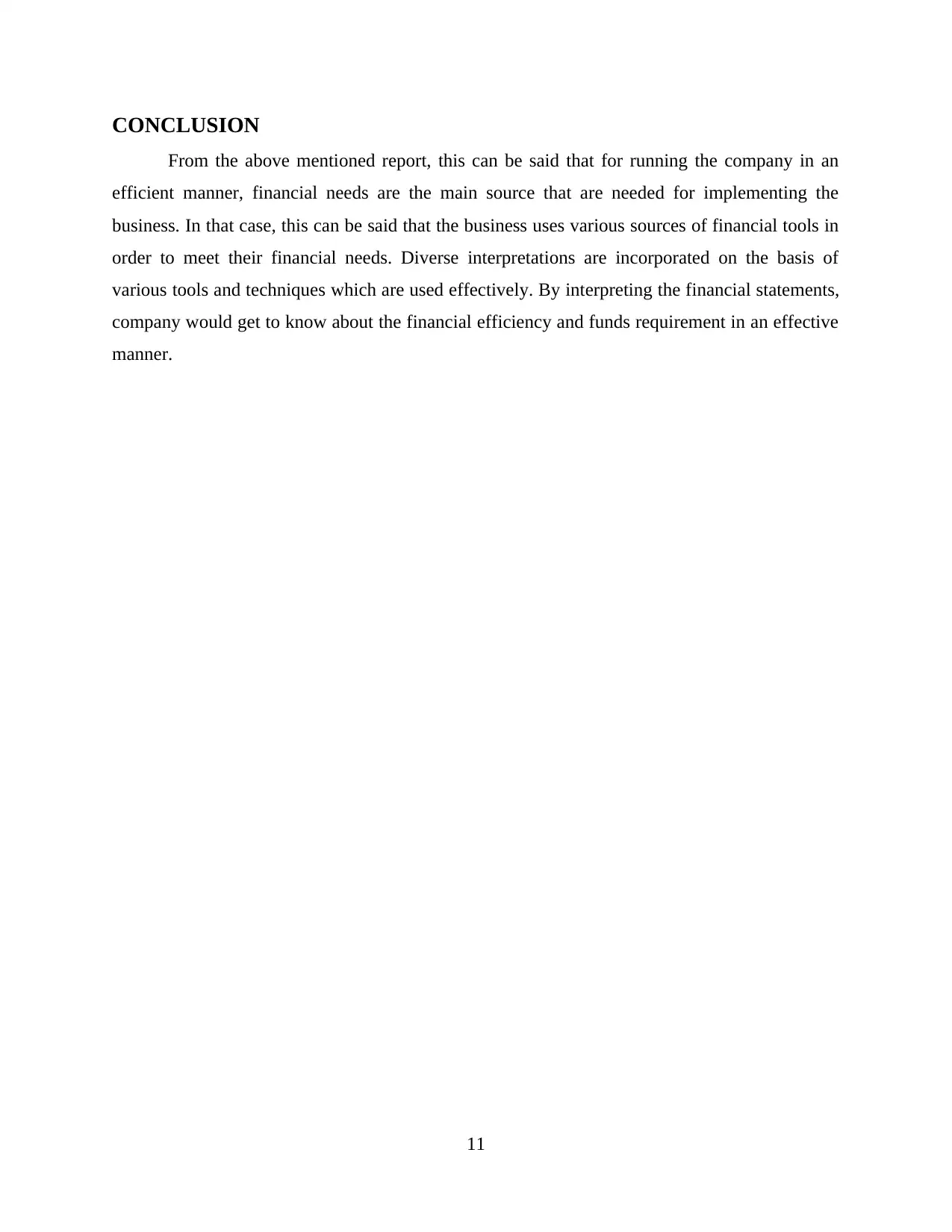
CONCLUSION
From the above mentioned report, this can be said that for running the company in an
efficient manner, financial needs are the main source that are needed for implementing the
business. In that case, this can be said that the business uses various sources of financial tools in
order to meet their financial needs. Diverse interpretations are incorporated on the basis of
various tools and techniques which are used effectively. By interpreting the financial statements,
company would get to know about the financial efficiency and funds requirement in an effective
manner.
11
From the above mentioned report, this can be said that for running the company in an
efficient manner, financial needs are the main source that are needed for implementing the
business. In that case, this can be said that the business uses various sources of financial tools in
order to meet their financial needs. Diverse interpretations are incorporated on the basis of
various tools and techniques which are used effectively. By interpreting the financial statements,
company would get to know about the financial efficiency and funds requirement in an effective
manner.
11
1 out of 13
Related Documents
Your All-in-One AI-Powered Toolkit for Academic Success.
+13062052269
info@desklib.com
Available 24*7 on WhatsApp / Email
![[object Object]](/_next/static/media/star-bottom.7253800d.svg)
Unlock your academic potential
© 2024 | Zucol Services PVT LTD | All rights reserved.





